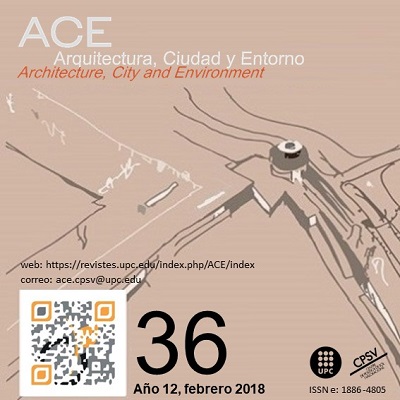The five categories of Solà-Morales as a legacy for reading the urban landscape
DOI:
https://doi.org/10.5821/ace.12.36.4791Keywords:
Urban Morphology, urban sprawl, urban planning, gated communitiesAbstract
Objective
Nearly forty years after Lynch (1960) proposed the use of his “five elements” to apprehend the “image of the city,” Solà-Morales (2002) published the article “Presente y futuros. Arquitectura en la ciudad” in which he also proposed five "concepts” or "platforms" focused on the changing dynamics and morphologies of 21st-century large urban areas. The objective of the study is to propose a method for analyzing the urban morphology of the rapid-growing new suburban areas in the city of Campinas, State of São Paulo, Brazil based on those five categories.
Methodology
The methodology consisted of analyzing Google Earth and Google Street View images, complemented by street level observations and photographs, under an approach that takes advantage of Solà-Morales' five categories as analysis units.
Conclusions
The paper concludes that local conditions tend to shape these (undergoing change) areas in ways that are in tune with the categories’ descriptions. The phenomenon was observed not only in Campinas, but also in other major cities of the State of São Paulo, Brazil. This shaping indicates a shift in the traditional hierarchical structure of the urban territories, with an emphasis toward new “mutation” areas.
Originality
The new method proposed by this paper, based on Solà-Morales’ revolutionary concepts, may trigger further investigations and unexpected results when applied to other metropolises throughout the globe.
Published
Issue
Section
License
| INTELECTUAL PROTECTION CRITERIA |
At this moment, it is count with the "Oficina Española de Patentes y Marcas", while global protection it is being processed by the World Intelectual Property Organization (OMPI/WIPO). Nevertheless the International Standard Serial Number Office (ISSN) has given the following numbers ISSN: 1886-4805 (electronic version) and 1887-7052 (paper version). All articles will be peer reviewed, using double blind reviewing. |
| COPYRIGHT |
The article contents and their comments are authors exclusive liability, and do not reflect necessarily the journal editor commitee's opinion. All ACE published works are subject to the following licence CC BY-NC-ND 3.0 ES http://creativecommons.org/licenses/by-nc-nd/3.0/es/ It implies that authors do not hold nor retain the copyright without restrictions but only those included in the licence. |


































